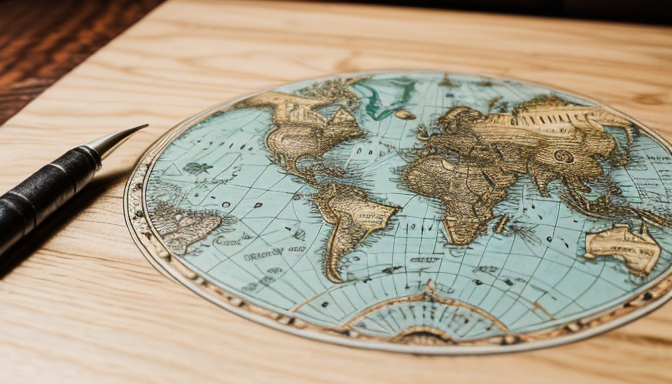Have you ever flipped through the pages of a fantasy novel and stumbled upon a map that made your heart race? Fictional maps are not just pretty pictures; they are intricate blueprints of entire worlds waiting to be explored. They serve as a gateway to immersive storytelling, inviting readers to traverse vast landscapes, navigate treacherous terrains, and uncover hidden realms. Imagine holding a treasure map that leads you through enchanted forests, over towering mountains, and into the depths of ancient kingdoms. That’s the magic of fictional cartography!
When we think about the design of these maps, it’s fascinating to see how different artistic styles come into play. Some maps are adorned with whimsical illustrations, while others boast a more realistic aesthetic. Each choice enhances the narrative, drawing readers deeper into the story’s universe. For instance, a map showcasing jagged mountains might symbolize the struggles faced by the characters, while lush valleys could represent hope and prosperity.
But what about the symbolism embedded within these maps? They often reflect the cultures and histories of the worlds they depict. A kingdom marked by borders may signify conflict, while a peaceful river could represent unity. These elements enrich the reader’s experience, allowing them to interpret the story on a deeper level. So, next time you come across a fictional map, take a moment to study its details—there’s a whole universe hidden in plain sight!
The Art of Cartography in Fiction
When we think of maps, we often picture a mundane representation of geography, but in the realm of fiction, cartography transforms into an art form that breathes life into imaginary worlds. Every line, every contour, and every label on a fictional map serves a purpose, guiding readers through the intricate landscapes of a story. Have you ever noticed how a well-crafted map can make a fantasy realm feel as real as our own? That’s the magic of cartography!
Take a moment to consider the landforms depicted in these maps. Mountains can symbolize challenges, while rivers might represent the flow of time or the journey of a hero. Each realm is meticulously designed to reflect the culture and history of its inhabitants. For instance, a kingdom bordered by treacherous cliffs may evoke a sense of isolation, whereas a sprawling valley might suggest abundance and community. The placement of borders can also speak volumes about the political tensions and alliances that shape the narrative.
In many cases, the artistic style of the map itself can enhance the storytelling experience. From hand-drawn illustrations to digital designs, the visual aesthetics can evoke emotions and set the tone of the entire world. Consider how a map with swirling lines and vibrant colors can invite readers to explore every nook and cranny, while a stark, monochromatic map might convey a sense of foreboding. Ultimately, the art of cartography in fiction is not just about geography; it’s about creating a gateway into a universe filled with adventure, conflict, and discovery.

Symbolism and Meaning in Map Design
When we dive into the world of fictional maps, we uncover a treasure trove of symbolism and meaning that goes far beyond mere geography. Each landform, realm, and kingdom border is meticulously crafted to enhance the storytelling experience. For instance, a jagged mountain range might symbolize the struggles faced by its inhabitants, while a winding river could represent the flow of time or the journey of a hero. These elements are not just decorative; they are integral to the narrative, inviting readers to explore deeper meanings.
Take a moment to consider how a map can reflect the cultures and histories of its world. For example, a kingdom with fortified borders might suggest a history of conflict, while lush, fertile lands could indicate a society that values agriculture and peace. Such details are essential for immersive worldbuilding, as they allow readers to connect with the story on a personal level. They can almost feel the weight of the past pressing down on the characters as they navigate their world.
To illustrate this point, let’s look at a simple table that outlines some common symbols found in fictional maps:
| Symbol | Meaning |
|---|---|
| Mountains | Challenges or obstacles |
| Rivers | Life and movement |
| Forests | Mystery or danger |
| Castles | Power and authority |
In conclusion, the symbolism embedded in fictional maps is a powerful tool for worldbuilding. It not only enriches the narrative but also invites readers to embark on their own journeys of discovery. So next time you find yourself gazing at a fantasy map, remember that every line and landmark holds a story waiting to be told.
Frequently Asked Questions
- What makes fictional maps important in storytelling?
Fictional maps serve as a visual guide, helping readers navigate the world created by the author. They enhance immersion, allowing readers to visualize locations, cultures, and journeys, making the narrative more engaging and relatable.
- How do artists create unique styles for fictional maps?
Artists often blend traditional cartography with imaginative elements, using vibrant colors, whimsical designs, and symbolic icons. This creative approach not only captures the essence of the story but also reflects the themes and emotions embedded in the narrative.
- Can the symbols on a map reveal deeper meanings?
Absolutely! Symbols on fictional maps often represent cultural elements, significant events, or character journeys. They can provide insights into the world’s history and themes, enriching the reader’s experience and understanding of the narrative.
- Are there any famous fictional maps that stand out?
Yes! Maps from works like J.R.R. Tolkien’s Middle-earth or C.S. Lewis’s Narnia are iconic. They not only guide readers through the stories but also become beloved artifacts in their own right, often sparking the imagination of fans worldwide.

Recent Comments